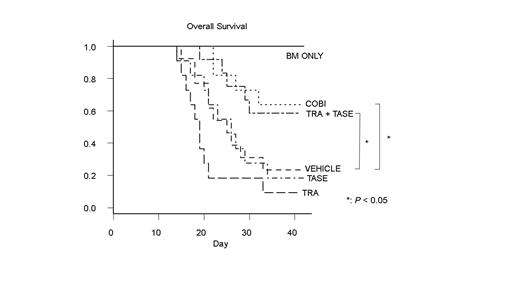Abstract
Introduction
Despite clinical development of novel immunosuppressants, the prognosis of pulmonary graft-versus-host disease (pGVHD) following allogeneic hematopoietic stem cell transplantation (allo-HSCT) is still poor. It is clinically classified into obstructive and constrictive subtypes, but its pathophysiology is not fully elucidated due to difficulty in collecting human lung specimens. We have shown that the MEK inhibitors that target the MAP kinase pathway suppress gastrointestinal and cutaneous GVHD in mice. Therefore, other kinase inhibitors may have potentials to suppress pGVHD. We here explored key molecules in pGVHD patients who underwent lung transplantation and verified the potency of dual inhibition of the MEK/ERK and PI3K/AKT pathways.
Methods
For human histopathological analysis, we reviewed 45 lung specimens from the allo-HSCT recipients who underwent lung transplantation at our institute for pGVHD from 2008 through 2018. Single-cell level imaging mass cytometry of human pGVHD specimens was performed to visualize interactions of lymphocytes and monocytes around bronchioles. As for a murine pGVHD model, eight-week-old B10.BR (H2K k) mice were pretreated with 240 mg/kg cyclophosphamide and 7 Gy total body irradiation, followed by infusion of C57BL/6J (H2K b) bone marrow cells and splenocytes. Vehicles, the MEK inhibitors trametinib (tra) 0.1 mg/kg/day, cobimetinib (cobi) 0.1 mg/kg/day, the PI3K inhibitor taselisib (tase) 5 mg/kg/day and tacrolimus (tac) 1 mg/kg were given from day 0 through 28. Evaluation was made at day 42 following transplant: primary endpoint was survival rate and secondary endpoints included development of bronchiolitis and values of airway resistance and lung compliance. Immunosuppressive effects of those reagents for human cells were evaluated in vitro: CSFE dilution of T cells stimulated with allogeneic dendritic cells; expression of CD23/CD69 on B cells activated with IL-4/CD40L; TNF-α production of monocytes stimulated with lipopolysaccharide.
Results
Three pathological findings characterize human pGVHD: bronchiolitis obliterans, lymphocyte infiltration and wall thickening of bronchioles; pleuroparenchymal fibroelastosis (PPFE), proliferation of subpleural elastic fibers; peribronchitis, macrophage aggregation around the bronchi. Most cases with PPFE had subpleural arteriovenous inflammation, and immunostaining revealed that B cells and macrophages were abundantly infiltrated around the bronchioles. These results indicated that suppressing B cells and macrophages may be crucial to prevent pGVHD through avoiding vascular inflammation and bronchiolitis.
In the murine pGVHD, cobi but not tra/tac improved survival rate (vehicle 31%; cobi 62%, tra 7%, tac 10% at day 42; p < 0.01). Cobi attenuated development of bronchiolitis, venulitis and peribronchial macrophage aggregation. Cobi improved respiratory functions, such as airway resistance (vehicle 1.65 ± 0.19, cobi 2.86 ± 0.75 cmH 2O.s/mL, p < 0.001) and lung compliance (vehicle 13.14 ± 0.71 cobi 8.99 ± 1.08 μL/cmH 2O, p < 0.05). Notably, T cell infiltration around bronchioles was inhibited by cobi and tra, but B cell infiltration was inhibited only by cobi.
Whereas cobi inhibited phosphorylation of AKT, tra compensatory upregulated it. Cobi inhibited B cell activation more than tra (%CD23 +CD69 + B cells: 32.8% with cobi 1μM, 53.0% with tra 1μM, p < 0.05). In addition, cobi suppressed TNF-α production by monocytes more strongly than tra (%TNF-α + monocytes: 53.1% with cobi 1μM vs 71.6% with tra 1μM, p < 0.05). Dual inhibition of the MEK/ERK and PI3K/AKT pathways with combination of tra and tase strongly suppressed B cells in vitro, and improved survival rate compared with vehicle and monotherapy of tra or tase in mice (Figure). Finally, imaging mass cytometry of human pGVHD specimens revealed that lymphocytes around bronchioles and venules were positive for phospho-ERK1/2 and phospho-AKT.
Conclusions
pGVHD is associated with vascular inflammation and bronchiolitis in humans and mice. Furthermore, phosphorylation of ERK1/2 and AKT is upregulated in human pGVHD. Given that dual inhibition of MEK/ERK and PI3K/AKT signaling suppresses vascular inflammation and bronchiolitis thorough inhibition of B cells and monocytes in mice, this strategy may provide a novel treatment option against human pGVHD.
Takaori-Kondo: ONO PHARMACEUTICAL CO., LTD.: Research Funding; Bristol-Myers K.K.: Honoraria; Celgene: Research Funding.


This feature is available to Subscribers Only
Sign In or Create an Account Close Modal